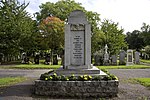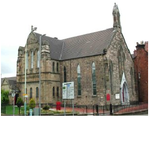Paisley Gilmour Street railway station
1840 establishments in ScotlandBuildings and structures in Paisley, RenfrewshireCategory B listed buildings in RenfrewshireFormer Glasgow and Paisley Joint Railway stationsListed railway stations in Scotland ... and 8 more
Pages with no open date in Infobox stationRailway stations in Great Britain opened in 1840Railway stations in RenfrewshireRailway stations served by ScotRailSPT railway stationsTransport in Paisley, RenfrewshireUse British English from February 2017Vague or ambiguous time from March 2012

Paisley Gilmour Street railway station is the largest of the four stations serving the town of Paisley, Renfrewshire, Scotland (the others being Paisley St. James, Paisley Canal and Hawkhead), and acts as the town's principal railway station. The station is managed by ScotRail and serves the Ayrshire Coast Line and Inverclyde Line, 7+1⁄4 miles (11.7 km) west of Glasgow Central. The station is protected as a category B listed building.
Excerpt from the Wikipedia article Paisley Gilmour Street railway station (License: CC BY-SA 3.0, Authors, Images).Paisley Gilmour Street railway station
Old Sneddon Street,
Geographical coordinates (GPS) Address External links Nearby Places Show on map
Geographical coordinates (GPS)
| Latitude | Longitude |
|---|---|
| N 55.8474 ° | E -4.4242 ° |
Address
Paisley Gilmour Street
Old Sneddon Street
PA3 2AG , Castlehead
Scotland, United Kingdom
Open on Google Maps









